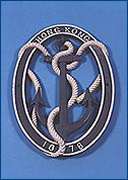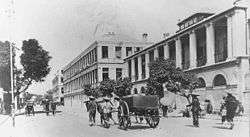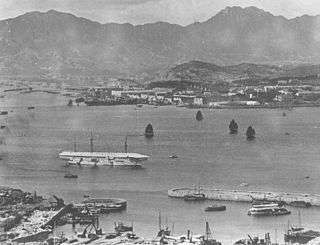HMS Tamar (shore station)
| HMS Tamar | |
|---|---|
| Stonecutter's Island, Hong Kong | |
 Gate emblem | |
| Type | Naval base |
| Site information | |
| Controlled by | RN |
| Site history | |
| Built | 1897–1997 |
| In use | 1897–1997 |
| Battles/wars | Battle of Hong Kong 1941 |
| Garrison information | |
| Past commanders | See Commander British Forces in Hong Kong |
| Garrison | British Forces Overseas Hong Kong (naval) |
HMS Tamar (Chinese: 添馬艦) was the name for the British Royal Navy's base in Hong Kong from 1897 to 1997. It took its name from HMS Tamar, a ship that was used as the base until replaced by buildings ashore.
History
19th century
The British Navy arrived during the First Opium War to protect the opium traders. Sir Edward Belcher, aboard HMS Sulphur landed in Hong Kong on 25 January 1841.[1] Possession Street still exists to mark the event,[1] although its Chinese name is 水坑口街 ("Mouth of the ditch Street").

Commodore Sir Gordon Bremer raised the Union Jack and claimed Hong Kong as a colony on 26 January 1841.[1] Naval store sheds were erected there in April 1841.[2] The site had been referred to as the "HM Victualling Yard" in the Navy's own register.[3] The first naval storekeeper and agent victualler, Thomas McKnight, appointed on 21 March 1842, served until October 1849. Early maps show that major construction was also carried out at another, slightly more westward site, between 1845 and 1855.[2] In fact, the naval authorities demolished the West Point store sheds and surrendered the land to the colonial government in 1854 in exchange for a plot of land where the Admiralty station of the Mass Transit Railway stands.[4]
The Second Opium War in China (1856–1860) caused a military build-up, in which the yard expanded westwards in April 1858. A victualling yard was added at what was then the North Barracks. Two officers were initially appointed as responsible for the machinery and spare parts, respectively, needed to maintain and repair ships in the dockyard, and for dry goods and foodstuff in the victualling yard.[4]
HMS Tamar, was a 3,650 ton British troopship launched in 1863. She first visited Hong Kong in 1878 with reliefs crews, returned once in 1886.[4] She finally arrived in Victoria City on 11 April 1897.[1] She was stationed permanently in the harbour from 1897 to 1941, when she was scuttled during the Battle of Hong Kong during World War II, to avoid being used by the invading Japanese Imperial forces.
20th century

At the turn of the 20th century, land adjacent to the site was needed for expansion. Unable to obtain it, as the site was surrounded by army barracks, the Navy began work on the construction of a floating basin (sheltered bay) and the reclamation of the east arm of the dockyard, in 1902. This project, involving 160,000 square metres of land reclamation, a 36,000 square metre floating basin to repair and refit vessels afloat, and also a 183-metre graving dock,[4] was completed by 1908.[3]
At the end of World War II, the Royal Navy re-established their naval base at Wellington Barracks, vacated by the British Army.[5]
On 28 November 1957, the Navy announced that the dockyard would be closed down over a 2-year period. However, in 1959, the Navy, which had retained some land on the waterfront, began planning a compact naval base on the site.[3]
From 1959 to 1962, the Wellington Barracks were upgraded to better serve the colony and reflect the changing times for the Royal Navy in the Pacific region. Old naval buildings were demolished, and the rubble used as landfill for the reclamation of the dry dock in October 1959.[3]
The Royal Navy decided to demolish the Wellington Barracks and build a modern naval facility in Hong Kong. The Prince of Wales Building was completed in 1978 and became the headquarters of the new naval base, HMS Tamar.
Shortly before the departure of British forces in 1997, the Tamar basin was reclaimed, and the People's Liberation Army of the People's Republic of China occupied the Prince of Wales Building (now Chinese People's Liberation Army Forces Hong Kong Building, or collectively with other buildings and the area enclosed by walls, the Central Barracks).
HM Naval Base was relocated to the northern side of Stonecutter's Island, off Kowloon, prior to the handover in 1997. On 11 April 1997, which marked the centenary of the HMS Tamar's definitive arrival, the British naval shore establishment in Hong Kong was de-commissioned.
The last HMS Tamar on Stonecutters Island is now a government marine facility, now known as the Government Dockyard. The vacated site in Central, Hong Kong Central, now known as the Tamar site, became a valuable piece of real estate and after much debate as to how to best use the site has now become the location of the new Hong Kong Government's Central Government Complex.
Squadrons in Hong Kong
The following is a list of naval squadrons and fleets that called Tamar home:
- China Squadron 1844–1941, 1945–1992
- Far East Fleet/HK Sqdn 1969–1971
- Dragon Squadron 1971–1992
- 3 Raiding Royal Marines
- Hong Kong Royal Naval Volunteer Reserves 1967–1996; merged with Royal Naval Reserve (RNR) 1971
- British Regular — Garrison and Fleet
- LEP 1905–1996
- Side Girls Party 1933–1997
- Dragon Squadron
- 120th Minesweeping Squadron 1958–1966; transferred to Singapore
- 6th Mine Countermeasure Squadron 1969–1997
- 6th Patrol Craft Squadron 1970–1997
- Operations and Training Base 1934–1997
- 3 Commando Brigade Royal Marines
- 47 Royal Marines
- British Pacific Fleet 1840s–1948; to Singapore as Far East Station
- HK Flotilla 1840s–1941, 1948–1992
- China Station — 4th Submarine Flotilla, Yangtse Flotilla, West River Flotilla, 8th Destroyer Flotilla
- 5th Cruiser Squadron
- 1st Escort Flotilla
- 4th Frigate Flotilla ?–1952
- Frigate Squadron 1952–1976
- Light Cruiser Squadron
- 415 Maritime Troop
Naval facilities
A list of facilities used or built by the Royal Navy in Hong Kong:
- Prince of Wales Building 1978–1997; now Central Barracks of the PLA
- Lamont and Hope Drydocks
- Aberdeen Docks — destroyed
- Dry Dock 1902–1959
- Taikoo Dockyard — Hong Kong United Dockyards
- Royal Navy Dockyards 1902–1959
- Sai Wan Barracks 1844–1846
- Wellington Barracks 1946–1978, as HMS Tamar (demolished)
- North Barracks 1850s–1856, 1887–1959; from the Army and to HK Government 1959
- Victoria Barracks
- Redoubt and Lei Yue Mun Fortifications 1885–1887
- Lei Yue Mun Fort 1887–1987
- Reverse, Central, West and Pass Batteries 1880s
- Brennan Torpedo station 1890 — Lei Yue Mun
- Royal Naval Hospital, Wan Chai; now Ruttonjee Sanatorium
- Seaman's Hospital 1843–1873; replaced by Royal Naval Hospital
- RMS Queen Mary 1945–1946, as a hospital
- War Memorial Hospital (Matilda) 1946–1959
- British Military Hospital 1959–1995
- Island Group Practice 1995–1997, replaced British Military Hospital
- HMS Charlotte and HMS Victor Emmanuel — Receiving Ships
- Tidal Basin 1902–1959
- Boat Basin 1902–1959
- HM Victualling Yards 1859–1946
A list of facilities used or built by the Royal Navy in Hong Kong:
- Guard Room
- Chichester Block
- Aberdeen Docks
- Royal Naval Hospital, Wan Chai; now Ruttonjee Sanatorium
- Seaman's Hospital 1843–1873
- HMS Tamar — Receiving ship 1897–1941
- HMS Minden 1841–mid-1840s — hospital ship
- HMS Alligator 1840s–1865 — hospital ship
- HMS Melville 1860s–1873 — hospital ship (East Indies Sqdn)
Ships
- Duty Boats – including Victoria
- RN Ferry Ah Moy
See also
References
- 1 2 3 4 Base closure to end Royal Navy's Far East presence, Associated Press, 4 November 1997
- 1 2 Eric Cavaliero, Harbour bed holds memories, The Standard, 13 November 1997, quoting P J Melson: White Ensign – Red Dragon: the History of the Royal Navy in Hong Kong 1841 to 1997
- 1 2 3 4 HMS TAMAR and the China Fleet Club, The Gun Plot
- 1 2 3 4 Eric Cavaliero, Harbour bed holds memories, The Standard, 13 November 1997
- ↑ HMS Tamar at The Royal Navy Research Archive
Further reading
- Harland, Kathleen (1985). The Royal Navy in Hong Kong Since 1841. Liskeard, England: Maritime Books. ISBN 9780907771197.
| Wikimedia Commons has media related to HMS Tamar (shore station). |
Coordinates: 22°16′51″N 114°9′56″E / 22.28083°N 114.16556°E